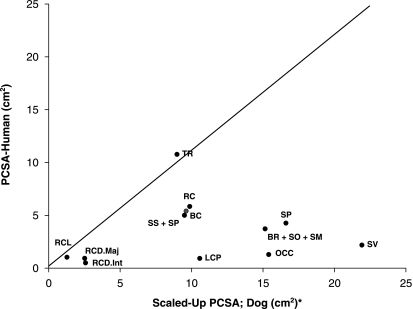Fig. 2.
Comparison of scaled PCSA values between dogs and humans (human data obtained from Kamibayashi & Richmond, 1998). Muscle abbreviations: TR, trapezius – cervical portion; BR, brachiocephalicus; SO, sterno-occipitalis; SM, sternomastoideus; RC, rhomboideus capitis and rhomboideus cervicis; SV, serratus ventralis cervicis; SP, splenius, BC, biventer cervicis; SS, scalenus supracostalis; SP, scalenus primae costae; LCP, longus capitis; OCC, oblique capitis caudalis; RCL, rectus capitis lateralis; RCD.Maj., rectus capitis dorsalis major; RCD.Int., rectus capitis dorsalis intermedius. Due to differences in nomenclature and anatomy between these species, the chart relates only to those muscles which were found to share similar function and structure. PCSA values of several muscles are summed (e.g. the human BR muscle is equivalent to the sum of the canine BR, SO and SM muscles), in order to enable comparison between muscles of the dog and human.

